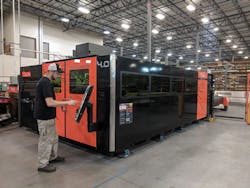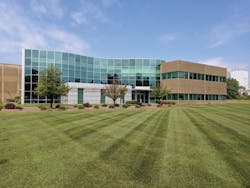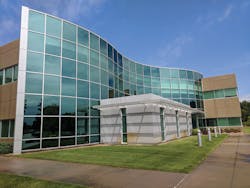Technology works with wide variety of metals for the architectural sector
KAYLEE SWEARINGEN
The architecture, engineering, and construction (AEC) industry’s projects range from simple joints that connect the ground to the foundation to incredibly complex such as skyscrapers with over 40 floors. From designing ideas to going vertical, the AEC is responsible for the structural environment we live in.
These projects start with project development, estimating, and discovering funding. It then moves to the pre-design phase, where the program is verified and architects are appointed. Following that, schematics are created, estimated, scheduled, and sent out to bidders. Once the project is awarded, the construction phase begins. Fabricators will then start the process of building the design elements that architects have virtually created. Fabricators bring architects’ digital ideas to life.
Innovation and sustainability
Bringing order to the chaos is national specialty metal fabricator Metal Design Systems’ (MDSI; Cedar Rapids, IA) solution to their part of the construction process. By compiling project information, schedules, and data, MDSI manages and manufactures each project seamlessly. MDSI serves the architectural sector, focusing on wall cladding, column covers, canopies, and other custom products (FIGURE 1).
FIGURE 1. Examples of MDSI’s specialty metal fabrications for the architectural sector are shown.
Advanced technology is empowering leaders to improve and accelerate environmental sustainability throughout the supply chain. MDSI takes on an environmentally responsible, conscientious approach throughout the manufacturing process.
“Our facility recycles 100% paper, cardboard, 90% wood scrap, and 83% metal scrap,” explains Dave Untiedt, chief operating officer at MDSI. But recycling is not MDSI’s only innovative and sustainable move. Continuously incorporating new methodology into their systems, MDSI works to add innovative features and installation improvement. One of their most recent additions was the purchase of a Mazak Optiplex 4020 DDL laser cutting machine (FIGURE 2).
FIGURE 2. MDSI recently added a Mazak Optiplex 4020 DDL laser cutting machine, which works with a wide variety of metals.
“Adding the direct-diode laser cutting machine absolutely helps us improve and innovate jobs. We can now aggressively chase projects that may not have fit our capabilities. With this additional machine, we have expanded our capabilities,” Untiedt states.
Flawless façade
Previously, MDSI was outsourcing aluminum plate, stainless steel, copper, and zinc. However, scheduling issues occurred and there were additional freight costs that required the projects to fit their vision for success. MDSI has a router table that covered some of their cutting, but it wasn’t enough. With pressure to complete projects faster, have a flawless finished look, and expand their material offerings, MDSI knew a change was needed.
“In the architectural metal business, architects like to use various types of metals. We needed something that could support and fabricate anything that the architectural world could imagine. The laser’s capabilities can significantly impact both design and material choice,” Untiedt says.
Considering options other than a laser was out of the question. MDSI was looking to expand its capabilities—specifically, the company wanted to efficiently cut materials other than aluminum composite material (ACM) and they knew that a solid-state laser was their solution.
“We knew a laser could perform well in light-gauge stainless steel and aluminum, but we also needed near-perfect edge quality,” Untiedt explains. “The solid-state laser market is where we knew we needed to be. We were looking for the best edge quality and best company to partner with on this purchase.”
Speed without compromise
Direct-diode laser (DDL) technology not only has speed and energy efficiency advantages, but it also has the edge quality that carbon dioxide (CO2) lasers offer. This is possible through DDL’s wavelength and beam profile.
“Edge quality is most important because it provides us the best visual quality without a lot of manual cleanup,” Untiedt states. “Because we serve the architectural industry, visual appeal is very important.” The Mazak Optiplex DDL was the key to speed and quality.
This system also provided MDSI with the table size needed. The architectural industry is looking for larger formats and this unit was what MDSI needed to fabricate larger panels. Untiedt explains, “Our typical size is 48 × 120 in., but we will occasionally go up to 60 × 144 in. and 192 in. We did not want to find ourselves in a situation where size was going to be an issue.”
The laser cutting machine has the latest PreviewG Control and drive system with integrated technology tables to simplify operations. It also incorporates Mazak’s intelligent Multi-Control Torch HP-D and Nozzle Changer technology to directly increase the productivity by allowing the machine to optimize the cutting head setup automatically for each program. This optimization dramatically improves cut speeds, increases throughput, and requires less operator intervention, delivering more predictable processing day after day.
“We felt Mazak genuinely cared about our success in adding to our fabricating capabilities,” Untiedt explains, “We went with the Optiplex because of the speed and edge quality.”
Direct advantages
Direct-diode laser cutting technology is different than fiber and CO2. The combination of wavelength and beam profile makes direct-diode technology a game-changer. The wavelength for direct-diode is absorbed into the metal better, which means faster cutting speeds, while the beam profile helps produce cleaner edge quality like the CO2 laser. This combination makes DDL technology a breakthrough performance machine.
“DDL is cutting faster than machines of like power across the board in all materials. The wavelength gives superior feed rate gains 30–40X faster in brass and copper,” explains Mark Mercurio, regional sales manager at Mazak Optonics. “Having that increased feed rate is great, but the key for MDSI is an excellent-looking part. Secondary processes are not an option because these parts are very decorative with many internal features. The cleanup just is too difficult with their application.”
Another aspect of DDL technology is energy efficiency: it has wall-plug efficiency around 45%, as the power source is more efficient because there is no gain medium that needs to be excited. DDL technology utilizes these diodes directly, eliminating the doped fiber system used in fiber laser technology.
Expanded opportunities
Notably, MDSI is now able to handle a variety of materials and can provide more services to architects. “We are now able to process mild steel and stainless steel in-house,” Untiedt says. “The Optiplex DDL provides us the opportunity to fabricate any type of metal an architect desires. This also provides us with more opportunities to broaden our company’s capabilities.”
Historically, MDSI has worked with these materials, but now with the cutting being in-house, MDSI saves significantly on lead times as well as freight costs. These benefits play a big role in what MDSI provides to their customers, as well as architects and building owners in what they are looking to design. The DDL allows MDSI to produce any custom pattern and/or design on architectural façade panels.
With this laser technology, MDSI offers the same products, but with new capabilities. They still offer column covers, canopies, wall cladding, and additional custom products. What changed are the materials available for these products. The ability to use the DDL gives MDSI the ability to process brass, copper, mild steel, stainless steel, and zinc.
“We at Metal Design Systems are excited about the capabilities now possible with the Mazak laser. We look forward to assisting our industry in designing a perfect fit,” Untiedt says.
Direct-diode laser technology has the speed and performance of fiber lasers with the beam shape and edge quality of CO2—a combination that is heating things up in the industrial laser industry and changing the game for fabricators.
KAYLEE SWEARINGEN ([email protected]) is a marketing specialist for Mazak Optonics. Elgin, IL; www.mazakoptonics.com.




